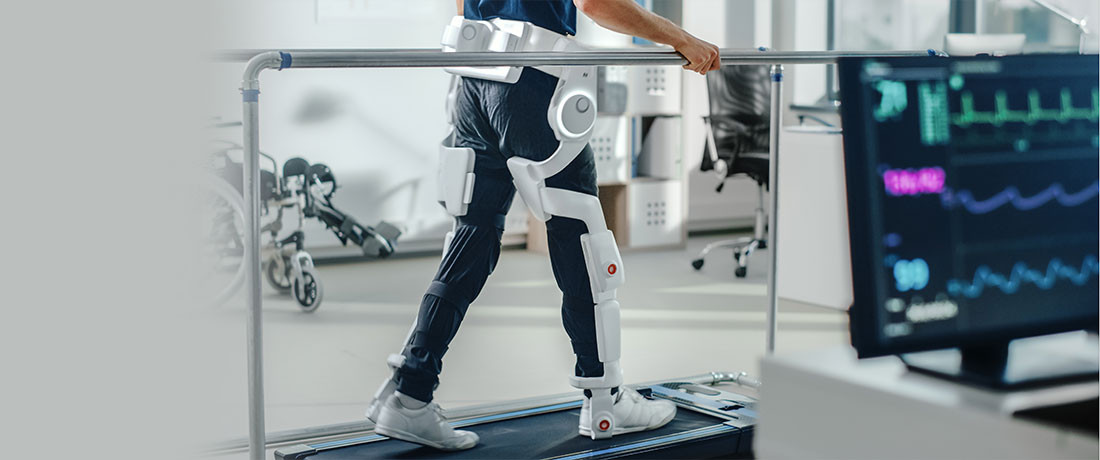The first step is always important
One of the major issues for patients suffering from stroke, partial or total paralysis of certain limbs, or a spinal cord/nerve injury is the issue of mobility, especially the ability to walk. As the above diseases/conditions often result in the inability of adults or children to walk independently, they can cause worry and uncertainty for patients who question their own capabilities. Some patients may also experience stress or depression.
Getting back to walking (once again) is therefore a great way to restore confidence and quality of life, for both patients and their families. In addition to the care and rehabilitation provided by our team of expert medical personnel, our patients also benefit from advanced robot-assisted gait training technology that is adapted to each individual patient’s ability, enabling them to achieve their goals at their own pace and as quickly as they are able.
The Physical Medicine and Rehabilitation Clinic, Samitivej Srinakarin Hospital, established the Am’walk Center to help rehabilitate patients with walking and mobility issues. The services provided at the center include mobility assessment and analysis as well as robot-assisted gait training. A variety of gait aids suitable to each patient’s individual ability level are also used, allowing patients to return to walking (once again) with confidence. We believe that taking the first step with confidence has a great impact on long-term quality of life.
Robotic & Exoskeleton Services: “We specialize in every walking issue”
Samitivej Srinakarin Hospital is the first private hospital to establish a gait and mobility rehabilitation center for patients of all ages. Our team of medical personnel specializing in the following areas of gait and mobility are ready to provide assistance to patients seeking to take their first steps (once again):
- Performance evaluation and analysis: evaluate and analyze walking problems
- Customized training programs: plan a gait training program tailored to meet the patient’s individual needs
- Device consultation: consultation services regarding appropriate equipment/technology including walking- and gait-related innovations such as exoskeletal or robot-assisted gait training, gait aids, and orthosis. The center provides these services in partnership with leading Thai and international companies, and patients are able to use the equipment most appropriate to their particular skill level. In the past, patients did not always receive all the necessary information about the different types of equipment available, which frequently resulted in patients and their families purchasing equipment that was not suitable for the patient’s individual needs and condition.
Medical Technologies
Robotic-assisted gait training is a technology that has been created and developed to overcome walking limitations with the use of robotic support. The main form of this technology is known as treadmill-based robotic gait training, which involves the use of a body-weight support system that controls the movement of the hip and knee joints while the patient practices walking. This type of robotic-assisted gait training is suitable for patients with mobility impairments who are unable to balance in a standing position on their own. The technology helps to ensure early ambulation, which is beneficial to the patient’s recovery. It can also help to reduce injuries that can result due to the patient’s inability to control their movements.
At the Am’walk Center we have implemented advanced technology and taken it to the next level with an emphasis on the use of mobile robotics—a new type of robotic-assisted training that is popular abroad. This type of robotic-assisted gait training allows for on-the-ground training so that the patient can walk freely in the direction of their choice. The exoskeleton acts like a part of the body that helps provide support and maintain balance while the patient moves. A team of doctors and physiotherapists will help to select the gait training robotics most suitable for each individual patient’s issues. Patients will be assessed for walking potential and ability, and the results will be matched to the level of assistance provided by each specific exoskeleton. This may also include other gait aids that the patient can use to practice walking safely.
The Am’walk Center provides assistance for individuals who are experiencing issues with standing, balance while standing, difficulty starting to walk, or abnormal walking patterns. This includes patients in the following 4 main groups:
- Stroke and traumatic brain injury (TBI) patients
- Patients with spinal cord injury (SCI)
- Elderly patients suffering from geriatric lower limb weakness or patients experiencing weight-bearing issues
- Children and adults with congenital cerebral palsy (CP)
International research studies have shown that mobile robotics for walking and gait training can help improve walking speed, endurance, and distance walked for spinal cord injury (SCI) patients.
Our Doctors
References:
What does best evidence tell us about robotic gait rehabilitation in stroke patients: A systematic review and meta-analysis. Journal of Clinical Neuroscience 48 (2018) 11–17.
Spinal cord injury
- The physiological cost index of walking with mechanical and powered gait orthosis in patients with spinal cord injury Spinal Cord (2013) 51, 356–359: Improve walking speed, the distance walked and the physiological cost index.
- Robotic exoskeletons: The current pros and cons. World J Orthop 2018 September 18; 9(9): 112-119.
Cerebral palsy
- Robotic Gait Training for Individuals With Cerebral Palsy: A Systematic Review and Meta-Analysis. Archives of Physical Medicine and Rehabilitation 2017, 98:2332-44: Meta-Analysis shows improvement of walking speed and endurance and improving gross motor function.
- Technological Advancements in Cerebral Palsy Rehabilitation. Phys Med Rehabil Clin N Am 31 (2020) 117–129.
